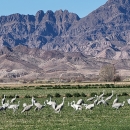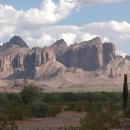Visit Us
National wildlife refuges offer us all a chance to unplug from the stresses of daily life and reconnect with our natural surroundings. Visitors have an opportunity to connect with nature in multiple ways. The lower Colorado River and its backwaters provide numerous outdoor recreational opportunities as well as a vital resource, water!
Driving Directions
From Yuma/Quartzite: Take Highway 95 (north from Yuma or south from Quartzite) and turn west onto Martinez Lake Road located between mile markers 46 and 47. Continue on Martinez Lake Road for approximately 10 miles. Turn north onto Red Cloud Mine Road. Follow the brown signs for three miles to the refuge and visitor center.
The refuge GPS coordinates are 32.99822, -114.48663.
Fees
There is no charge to visit.
Restrooms
Restrooms are available inside the refuge headquarters/visitor center. There are also comfort stations located in the headquarters parking lot, Meers Point, and Painted Desert Trail.
Points of Interest
Let our staff and volunteers at the visitor contact station help you plan your visit! This is a great starting point for visitors to become more familiar with the refuge and the wildlife that live here. Visitors can watch a 10 minute refuge orientation video, see live native fish on display, browse nature and wildlife exhibits, and obtain maps and brochures.
What To Do
If you have 15-minutes.
- Stop by the visitor center to browse the exhibits, pick up brochures, and ask questions.
- View the refuge from the observation platform near the visitor center.
If you have one hour.
- Hike the Meers Point trail from the visitor center to Meers Point and back.
If you have half a day or more.
- Hike the Painted Desert trail.
- Explore the wilderness area wilderness area
Wilderness areas are places untamed by humans. The Wilderness Act of 1964 allows Congress to designate wilderness areas for protection to ensure that America's pristine wild lands will not disappear. Wilderness areas can be part of national wildlife refuges, national parks, national forests or public lands managed by the Bureau of Land Management.
Learn more about wilderness area .
Know Before You Go
Visitors should bring plenty of drinking water, snacks, insect repellent, sunscreen, and other necessities. Please dress appropriately for the seasons, summer temperatures can be extreme while winter temperatures are mild to moderate.
Visitor Tips
Wildlife viewing tips include:
- Dawn and dusk are the best times to see wildlife.
- In warmer seasons, few animals are moving on hot summer afternoons or on windy days.
- Observe from the sidelines. Leave “abandoned” young animals alone. A parent is probably close by waiting for you to leave.
- Don’t offer snacks to wildlife; your lunch could disrupt wild digestive systems or lead to the animal's premature death.
- For a closer look, bring binoculars.
- Try sitting quietly in one good location. Let wildlife get used to your presence. Many animals that have hidden will reappear once they think you are gone.
- Walk quietly, being aware of sounds and smells. Often you will hear more than you will see.
- Teach children quiet observation. Other wildlife watchers will appreciate your consideration.
- Look for animal signs. Tracks, scat, feathers, and nests left behind often tell interesting stories.
Activities
Imperial National Wildlife Refuge offers wildlife-dependent recreational opportunities, including wildlife observation, hiking, hunting, fishing and wildlife photography. We hope that you enjoy this public resource to the best of your ability. Please note that overnight camping is not permitted on the refuge.
Trails
Meers Point Trail
- Open Season: Year-round
- Length: 0.8 miles
- Location of trail: The trail is accessible from the headquarters/visitor center or Meers point.
- Surface: Gravel
- Difficulty: Moderate
- Information: This one-way trail travels between the visitor center and Meers Point Recreation Area. There are opportunities to see desert plants and wildlife including birds, coyotes, and mule deer. An observation platform is located at the trail head. A comfort station, picnic tables, boat launch, and trash receptacle are located at Meers Point.
Painted Desert Trail
- Open Season: Year-round
- Length: 1.3 miles
- Location of trail: The trail head is located approximately 3 miles north of the headquarters/visitor center via Red Cloud Mine Road.
- Surface: gravel
- Difficulty: Moderate
- Information: This trail offers an amazing panoramic view of the Colorado River valley and a rainbow of colors produced by 30,000 year-old volcanic ash formations. Explore and enjoy the desert’s uniquely adapted landscape and the plants and wildlife that thrive here.
Other Facilities in the Complex
Imperial National Wildlife Refuge is part of the Southwest Arizona National Wildlife Refuge Complex.
Rules and Policies
There are a lot of fun, interesting, and educational things you can do on the refuge. Keep in mind, if an activity is not wildlife related and doesn't help in the protection or understanding of wildlife or their habitat, there are probably refuge rules governing this activity. Please check with the refuge management before participating in an activity that could harm the environment or yourself. There are plenty of activities at Imperial National Wildlife Refuge for you to enjoy. Be safe and have fun!
Locations
From Yuma/Quartzite: Take Highway 95 (north from Yuma or south from Quartzite) and turn west onto Martinez Lake Road located between mile markers 46 and 47. Continue on Martinez Lake Road for approximately 10 miles. Turn north onto Red Cloud Mine Road. Follow the brown signs for thee miles to the refuge and visitor center.


